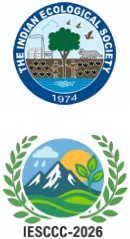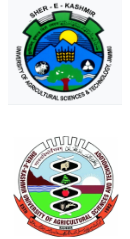Behavioural Hormoligosis in Oviposition Preference of Bemisia tabaci (Gennadius) in Bt Cotton
Simranjit Kaur, Vijay Kumar and Manjeet Kaur Sangha1
Department of Entomology, Punjab Agricultural University, Ludhiana-141 004, India
1Department of Biochemistry, Punjab Agricultural University, Ludhiana-141 004, India
Corresponding author’s email: cccjk2026@gmail.com
Keywords: Bemisia tabaci, Hormoligosis, Insecticides, Oviposition
1. Background
Whitefly, Bemisia tabaci (Gennadius) is key pests of many field and horticultural crops. It has assumed the status of a serious pest of cotton in the recent past and during kharif 2015, it appeared in epidemic form in Punjab and Haryana (Kumar et al 2020). The spray of synthetic pyrethroid and organophosphate group of insecticides changed the physiology and behaviour of whitefly (Abdullah et al 2006) but the exact mechanism by which it favoured whitefly is not known. The present study carried out to determine the influence of some insecticides on ovipositional behaviour of whitefly and biochemical composition of cotton leaves.
2. Material and methods
The study was carried out twice in open field on Bt cotton at Entomological Research Farm, PAU, Ludhiana during 2018 and 2019. Whitefly colonies were maintained on unsprayed potted plants in the separate screenhouse. The insecticides namely flonicamid 50WG (100 and 200g/ha), pyriproxyfen 10EC (625 and 1250ml/ha), spiromesifen 22.9SC (250 and 500ml/ha), fipronil 5SC (1000 and 2000ml/ha), ethion 50EC (1000 and 2000ml/ha) and bifenthrin 10EC (450 and 900ml/ha) were repeatedly (once, twice and thrice) sprayed at weekly interval on potted plants. A total of 117 potted plants were selected and divided into three sets (set I, II and III) each containing 39 plants. After 72 hours of first, second and third application of insecticides in set I, II and III, respectively, the treated potted plants were used for studying the ovipositional preference under multiple choice test. The sprayed and unsprayed cotton leaves were analyzed for estimation of total soluble sugars (Dubois et al 1956), total phenols (Swain and Hillis 1959). Standard analysis of variance technique for the analysis of completely randomized design was used. Post-hoc analysis was done by Duncan, using IBM SPSS statistics 20 software. Oviposition preference of whitefly were calculated and their significance was assessed using student’s t-test.
3. Results and conclusion
The impact of biorational (flonicamid, pyriproxyfen, spiromesifen) and conventional insecticides (fipronil, bifenthrin and ethion) was evaluated in term of oviposition preference by whitefly to treated cotton plants by multiple-choice test during 2018 and 2019. Whitefly had significantly higher oviposition preference towards plants treated with bifenthrin @ 900ml/ha (186.67eggs/leaf) and fipronil @ 1000ml/ha (171.33eggs/leaf) over untreated control (100.67eggs/leaf) based on overall mean of two years data. However, it showed least preference towards plant treated with spiromesifen @ 500ml/ha (32.11eggs/leaf), flonicamid @200g/ha (35.22eggs/leaf) and pyriproxyfen @ 1250ml/ha (53.28eggs/leaf). The results obtained from biochemical studies revealed that bifenthrin and fipronil treated leaves showed significant increase in total soluble sugar, reducing sugar content whereas total phenol and tannin content was significantly decreased in bifenthrin treated leaves. Biochemical parameters like total sugars and reducing sugars showed significant positive correlation; phenols and tannins had significant negative relationship with oviposition preference of whitefly. It may be concluded that bifenthrin and fipronil treated Bt cotton plants are nutritionally superior host for whitefly and led to behavioural hormoligosis in oviposition preference by whitefly.
References
Abdullah NMM, Singh J and Sohal BS 2006. Behavioral hormoligosis in oviposition preferences of Bemisia tabaci on cotton. Pesticide Biochemistry and Physiology 84: 10-16.
Kumar V, Kular JS, Kumar R, Sidhu SS and Chhuneja PK 2020. Integrated whitefly [Bemisia tabaci (Gennadius)] management in Bt cotton in north India: An agroecosystem-wide community based approach. Current Science 119(4): 618-624.

